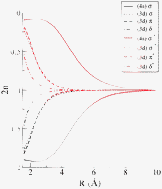The natural orbital functional theory of the bonding in Cr2, Mo2 and W2
Abstract
In this paper, we present for the first time a description based on the natural orbital functional theory (NOFT) of the group VI dimers, namely, Cr2, Mo2 and W2. The PNOF5, Piris Natural Orbital Functional, has been used throughout this work, and the results are compared to multireferential perturbation theory (CASPT2) results. Both methods have been combined with effective core potentials to take into account the scalar relativistic effects. In addition, for Cr2, an all-electron TZVP quality basis set has also been used to recover the core-valence dynamical correlation. In all cases, PNOF5 shows better behavior than CASPT2, which needs a larger basis set to recover comparable amounts of dynamical correlation. PNOF5 is able to account for the non-dynamical electron correlation, which is responsible for the multireferential nature of these dimers. However, it does not fully recover the dynamical correlation, which is crucial for the accurate description of these challenging potential energy curves. Consequently, PNOF5 predicts longer equilibrium distances and lower dissociation energies than the experimental values. Unlike CASPT2, the PNOF5 results do not significantly improve by using larger basis sets. These new findings represent a major step in the NOFT development, since PNOF5 is the first functional of the natural orbitals reported to yield a chemically balanced and accurate description of these challenging transition metal dimers.


 Please wait while we load your content...
Please wait while we load your content...